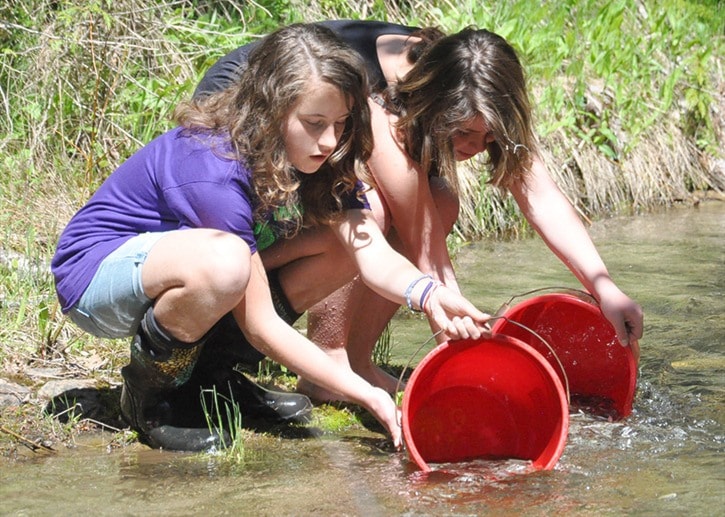With the help of Crawford Bay Elementary-Secondary School students, about 92,000 kokanee fry were released into Crawford Creek on Thursday, part of a project by the Eastshore Freshwater Habitat Society (EFHS).
It took about 45 minutes for participants to place the fry in the creek and a manmade channel, shuttling them in buckets from a Freshwater Fisheries Society of BC tank truck.
“What we want to do is improve the fish habitat on the East Shore,” said EFHS president Mike Jeffery.
 The survivors of the several-month-old fry released Thursday won’t return to the creek to spawn for three or four years, giving the society, certified through the Pacific Streamkeepers Federation, time to obtain additional funding for a remediation project.
The survivors of the several-month-old fry released Thursday won’t return to the creek to spawn for three or four years, giving the society, certified through the Pacific Streamkeepers Federation, time to obtain additional funding for a remediation project.
“Sometimes, it’s just as simple as putting log berms in and overhanging trees — making places they can live,” Jeffery said. “If we get the habitat improved, fish will come back to the habitat.”
Crawford Creek and others on Kootenay Lake’s East Shore — including Riondel’s Hendryx Creek, which had 5,000 released — used to teem with spawning kokanee in late summer. But since dams have been built upstream, the lake’s annual fluctuation has dropped from 30 to 13 feet, reducing available nutrients and food — and fish.
“I’ve seen how it’s depleted,” Jeffery said.
Efforts to boost the kokanee population are nothing new to the area. Over 20 years ago, Jeffery said, the school used to receive milked and fertilized eggs to hatch.
And nitrogen and phosphorus, both needed for metabolic processes, are put into the lake (the M.V. Balfour is charted and the mixture blended in its wake).
But spawning numbers are at their lowest, said Jeff Burrows, senior fish biologist with Ministry of Forests, Lands and Natural Resource Operations, so stronger measures are being taken. The allowed daily catch of kokanee has been reduced from 15 to zero, while the allowance for their main predator, Gerrard rainbow trout — each of which can eat 100 kokanee each year — has been upped from two to four.
“There’s no reason to expect that nature would balance that out,” said Burrows. “We’re trying to speed that up.”
Survivors from a spawning cycle can range from 0.5-5 per cent, so 1,800-2,000 returning to spawn in Crawford Creek would be ideal. But with that cycle taking three or four years, only time will tell if the restocking effort was a success.
“They have to imprint,” Burrows said. “We don’t know if that’s going to happen with fry raised in the hatchery.”

